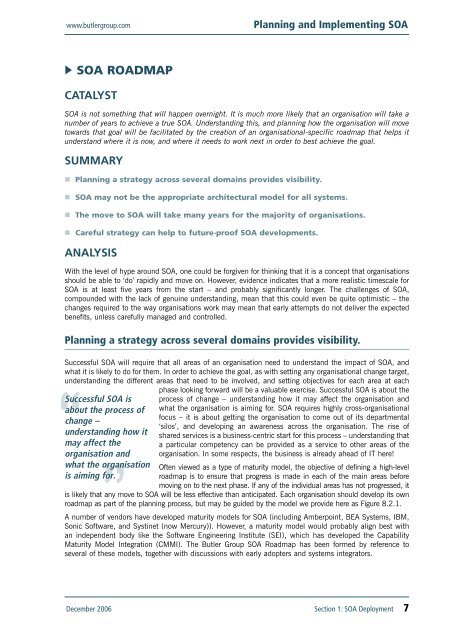Planning_and_Impleme.. - didier beck weblog
Planning_and_Impleme.. - didier beck weblog
Planning_and_Impleme.. - didier beck weblog
Create successful ePaper yourself
Turn your PDF publications into a flip-book with our unique Google optimized e-Paper software.
www.butlergroup.com<br />
<strong>Planning</strong> <strong>and</strong> <strong>Impleme</strong>nting SOA<br />
SOA ROADMAP<br />
CATALYST<br />
SOA is not something that will happen overnight. It is much more likely that an organisation will take a<br />
number of years to achieve a true SOA. Underst<strong>and</strong>ing this, <strong>and</strong> planning how the organisation will move<br />
towards that goal will be facilitated by the creation of an organisational-specific roadmap that helps it<br />
underst<strong>and</strong> where it is now, <strong>and</strong> where it needs to work next in order to best achieve the goal.<br />
SUMMARY<br />
<strong>Planning</strong> a strategy across several domains provides visibility.<br />
SOA may not be the appropriate architectural model for all systems.<br />
The move to SOA will take many years for the majority of organisations.<br />
Careful strategy can help to future-proof SOA developments.<br />
ANALYSIS<br />
With the level of hype around SOA, one could be forgiven for thinking that it is a concept that organisations<br />
should be able to ‘do’ rapidly <strong>and</strong> move on. However, evidence indicates that a more realistic timescale for<br />
SOA is at least five years from the start – <strong>and</strong> probably significantly longer. The challenges of SOA,<br />
compounded with the lack of genuine underst<strong>and</strong>ing, mean that this could even be quite optimistic – the<br />
changes required to the way organisations work may mean that early attempts do not deliver the expected<br />
benefits, unless carefully managed <strong>and</strong> controlled.<br />
<strong>Planning</strong> a strategy across several domains provides visibility.<br />
Successful SOA will require that all areas of an organisation need to underst<strong>and</strong> the impact of SOA, <strong>and</strong><br />
what it is likely to do for them. In order to achieve the goal, as with setting any organisational change target,<br />
underst<strong>and</strong>ing the different areas that need to be involved, <strong>and</strong> setting objectives for each area at each<br />
Successful SOA is<br />
about the process of<br />
change –<br />
underst<strong>and</strong>ing how it<br />
may affect the<br />
organisation <strong>and</strong><br />
what the organisation<br />
is aiming for.<br />
phase looking forward will be a valuable exercise. Successful SOA is about the<br />
process of change – underst<strong>and</strong>ing how it may affect the organisation <strong>and</strong><br />
what the organisation is aiming for. SOA requires highly cross-organisational<br />
focus – it is about getting the organisation to come out of its departmental<br />
‘silos’, <strong>and</strong> developing an awareness across the organisation. The rise of<br />
shared services is a business-centric start for this process – underst<strong>and</strong>ing that<br />
a particular competency can be provided as a service to other areas of the<br />
organisation. In some respects, the business is already ahead of IT here!<br />
Often viewed as a type of maturity model, the objective of defining a high-level<br />
roadmap is to ensure that progress is made in each of the main areas before<br />
moving on to the next phase. If any of the individual areas has not progressed, it<br />
is likely that any move to SOA will be less effective than anticipated. Each organisation should develop its own<br />
roadmap as part of the planning process, but may be guided by the model we provide here as Figure 8.2.1.<br />
A number of vendors have developed maturity models for SOA (including Amberpoint, BEA Systems, IBM,<br />
Sonic Software, <strong>and</strong> Systinet (now Mercury)). However, a maturity model would probably align best with<br />
an independent body like the Software Engineering Institute (SEI), which has developed the Capability<br />
Maturity Model Integration (CMMI). The Butler Group SOA Roadmap has been formed by reference to<br />
several of these models, together with discussions with early adopters <strong>and</strong> systems integrators.<br />
December 2006 Section 1: SOA Deployment 7





